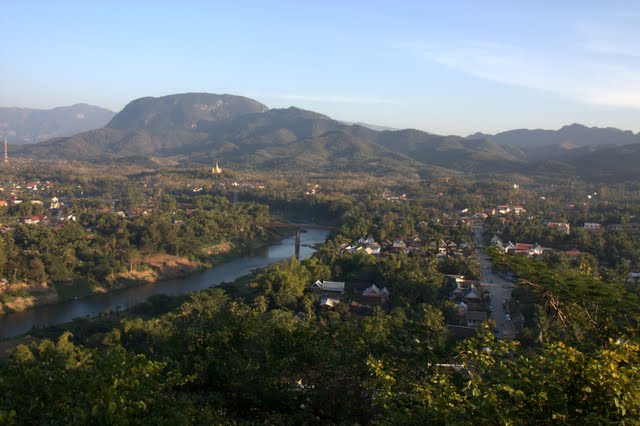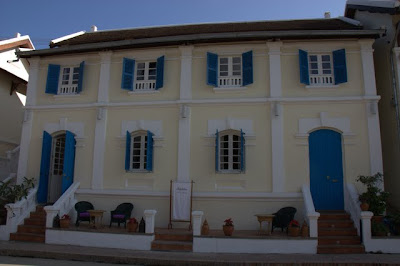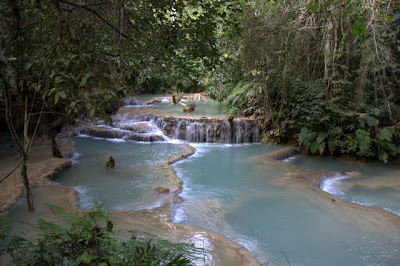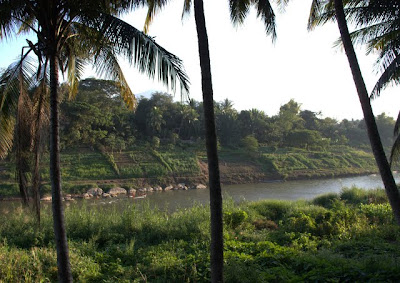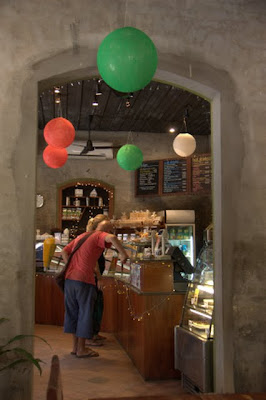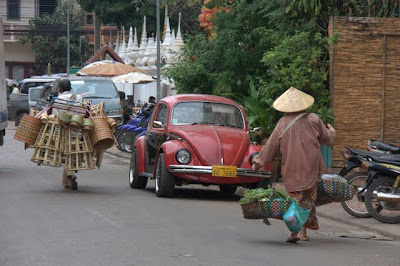Lou-ahng Prah-bang
I’m really bad at foreign pronunciations. Like, REALLY bad. And Sean isn’t much better, which usually leads to horrendous butchering of our upcoming destinations until we can get there and figure out how in the hell to say the names. I even mispronounce easy words. I always pick the wrong way to say it. But wouldn’t you agree that Lou-ahng Prah-bang is so much more fun to say than Lou-ong Prah-bong? I thought so.
Our eight days in Luang Prabang, like much of our time in Laos, were spent chilling and taking in the lovely surroundings. We’d usually muster up the energy to engage in one “activity” per day, if you count eating chocolate chip cookies at our favorite cafe as an activity, which I do.

Rules on the back of our hotel door. Number 5 amused me because it apparently okay to have a one night stand, just as long as no love is involved. Number 6 is very upsetting and foiled our plans.
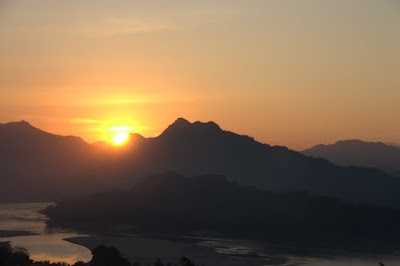
Sunset over the Mekong viewed from Phou Si Hill. Where you get a great view of the Mekong and the gorgeous greenery around town (see above)...

...shared with hundreds of your new best friends. Yes, you won't be the only one in Luang Prabang, and you probably won't learn much about local culture while your there, but gosh darn it, Luang Prabang is beautiful.

The Luang Prabang night market. We must have walked through it at least once per day but never bought anything. I may or may not have added to my growing scarf collection from one of the fair trade stores in town, however.

A hundred thousand times better than getting up at the crack of dawn to watch the alms giving ceremony is simply monk-spotting around town. We spotted these monks having fun and goofing around during bath time in the river. Every thing about the moment was beautiful - the lighting in the late afternoon sun, their orange robes against the riverside greens, the spontaneity of it all, and the joy of the monks without our intrusion on their fun. (If you go to the alms ceremony, which we did, I know you won't be THAT tourist who sticks his or her camera right in the monks' faces, right? We saw way too many of THOSE tourists treating the monks like zoo animals instead of showing respect for their religious ceremony).

Along Luang Prabang's riverfront. Luang Prabang sits alluringly between the Mekong River and the Mae Kok River.

In a town full of cafes, Saffron was our absolute favorite. Between their free wi-fi, real deal chocolate chip cookies, their organic, fair-trade local coffee, and their huge breakfast combos with bacon and cheese eggel bagels, tropical fruit salad, and cinnamon rolls, we were in heaven.

The French Indochinese architecture around town is what put Luang Prabang on the map as a UNESCO World Heritage Site.

Veggie street buffet. Gotta love a heaping plateful of dinner for just $1.25. Choose your dishes wisely - the ladies running the buffet dump all your choices together to heat them up.

Kouang Si Waterfalls, outside of Luang Prabang. The most gorgeous falls we've seen - since Plitvice National Park, that is.
Laos, the Bird’s Eye View.
Laos. (Don’t ask me if it is pronounced Lao or Laos, because I still don’t have the foggiest clue. I heard it both ways while we were there). I wouldn’t know much about this landlocked, socialist country, except I’ve been reading travel blogs for years. And for years, people have been touting Laos as the “undiscovered gem” in Southeast Asia. Perhaps at some point that was true, but trust me, you won’t be the only person traveling through Laos. In fact, a lot of our stops in Laos seemed to be the most touristy we’ve experienced in Southeast Asia. The Laotian government removed roadblocks to visitors traveling to Laos in the nineties; now, one in every 10.9 jobs in the country is in the tourist industry and 1.876 million people visited the country in 2010. Pretty remarkable when you think about how the country only has 6.8 million people. But it is true that Laos is less crowded than its neighbors and gives you room to breathe.
While we were there, I felt like Laos was noticeably more expensive than Thailand. As it turned out, we spent $8 less per day in Laos than we did in Thailand. I suppose we thought Laos was more expensive at the time because you get better value for your money in Thailand: more amenities, more modern. I suppose at the time of our purchases, we thought Laos should have been cheaper since it was less developed. But here’s the funny thing about Laos. There really aren’t any big cities. The capital city is only getting its first movie theater this year. There are only a handful of paved roads criss-crossing the country. Most people live in wooden shacks along dirt roads. But you can find a trendy cafe in many towns where the tourists frequent with a computerized cash register, free wi-fi, and coffee drinks that wouldn’t be out of place anywhere in the Western world. There are two economies in Laos: the local economy and the tourist economy. And more so than anywhere else in Southeast Asia, the economies don’t really mingle together. Sure, you can ride transport or eat with locals, but you have to go out of your way to do so. Laos is one of the poorest countries in the world, but you may not even notice if you don’t leave the tourist areas.
Our original plan was to blitz through in a week. We ended up staying 24 days. A week seemed reasonable last winter sitting in our apartment, staring at maps and planning our itinerary. Laos is kind of small, we figured. But unless you fly in and back out, a week won’t get you anywhere. Laos is the kind of place that takes a while to get around. Its also the kind of place that draws you in slowly and encourages meandering. These factors, along with a drawn out stomach bug for me in Luang Prabang and Vientiane, meant that we stayed longer than we planned. I didn’t realize how laid back Laos was until after we left and were in the middle of a whirlwind of scooters and people in Phnom Penh.
The two most-talked about aspects of Laos is the fantastically tasty and cheap Beer Lao, which we’ve covered, and the concept of Lao time. Everything was always hurry up and wait, hurry up and wait, probably best epitomized by a shuttle to an overnight bus we took in Vientiane. The shuttle came at the last possible minute to pick us up. At every pick-up, the driver threw the luggage in the back of the truck, and sped off before the new passenger ever sat down. Suddenly, he pulled over to the side of the road and there we sat. When asked what we were doing, he only told us, “No worries, no worries.” Just as suddenly as we pulled over, he was yelling for everyone to get back in the truck and we were careening down the road, chasing after our bus. Hurry up and wait, hurry up and wait, and always no worries.
Less discussed is the abundance of old VW Beetles throughout the country, giving rise to another item to add to my wanderlist: road tripping in Southeast Asia in a Bug. It will happen.
Unlike the Thais or the Cambodians, who are all smiles all of the time, the Lao people are more reserved. At first I thought the people we encountered were rude, but it just took longer to coax a smile out. Laos felt traditional; lots of families gathered together to eat communal meals outside and women wore long, silk skirts to sit side-saddle on motorbikes. One of the first things we noticed upon entry were the adorable Lao babies. There were tons of them, and almost always to mothers who looked babies themselves – probably because Laos has the youngest population in Asia. The Lao food wasn’t spectacular, but it was usually cheap, and there are plenty of tasty cafes with French influence, leftover from the days when Laos was part of French Indochina. The raw beauty of the country is stunning, and is reason alone to visit. Visiting central Laos was enjoyable, but we didn’t become engaged with Laos until we ventured to the less-visited south. Come explore Laos with us…

A bar called Utopia in Luang Prabang. Laos is the most bombed country in the world, per capita, courtesy mostly of the United States. More on that later.
The Slooooooooooow Boat to Luang Prabang
After leaving spending Christmas in Chiang Mai, we were determined to get to Laos to ring in 2011. So of course we took the slowest way possible. Over the course of three days, we traveled from Chiang Mai, Thailand to Luang Prabang, Laos by a combination of bus and a slow boat (not to mention pick-up trucks, songtheaws, and a “ferry”). They call it the slow boat because it involves two very long days of cruising on the Mekong River, as opposed to the fast boat that makes the trip in a zippy six hours but requires motorcycle helmets and a potential death wish. Here’s how it all went down:
Day One: Ride what is a serious contender for our worst bus yet from Chiang Mai to Chiang Khong on the border. The ride was at least seven hours and I spent all seven of those hours smooshed in between Sean on my left and a Thai boy on my right because why have four seats across when you can have five? I’m certain the Thai boy had to be upset with his dumb luck getting stuck next to the two ginormous Westerners but these seats weren’t even wide enough for five Thai people to sit comfortably. Of course there was obnoxiously loud music; it is Southeast Asia, after all.
Day Two: First leg of the slow boat. On the first leg, you alternate between, this sucks and this is awesome. They say it is easy to meet new people on the slow boat to Luang Prabang and it is true; misery loves company. Shortly after departing from the border, we met our German counterparts, Rod and Lizzy, who we ended up traveling with for the better part of two weeks. Besides meeting new friends, the first leg is characterized by consumption of Beer Lao and daydreaming while gazing at the Mekong. The views are fantastic, but the seats are not. Unless you arrived at least three hours early to grab the “premium” seats (i.e., old car seats), you were stuck sitting on a “handcrafted” bench. I’m not sure what would be worse – extending the already long day by three whole hours or sitting on the benches, which are basically two narrow pieces of wood nailed to each other in a crude fashion. I really don’t know whose butt would fit on those things, but my first impression of the Lao people is that they are even smaller than the Thais so maybe it is possible that a Laotian butt would fit. If you are considering taking the slow boat, B.Y.O.C. is a must. Your butt will thank you.
Day Three: After spending the night in Pakbeng freezing in a room with a broken window, and being very confused as to why we could see our breath in the tropics, we board the slow boat for the second leg. Of course all of the “premium” seats were gone, so we snagged our own wooden bench and waited for the boat to depart. As with day one, the slow boat doesn’t leave anywhere near the time it is supposed to. Our first introduction to Laos: the land of hurry up and wait.
We sat there, getting more and more hemmed in by the never ending stream of backpackers boarding the boat, and wondering how in the hell they are going to fit all of those people. Just when you thought another person couldn’t possibly fit, someone else who slept in would straggle down the hill. I’m not sure exactly how many people filled the boat, but at one approximate count it was over 100. Here’s the thing; on the first boat leg, they split the group into two boats, but on the second leg, they put everyone on the same boat. By the time we pulled away from shore, we were down to one bench and a small space on the floor. Within the hour, Sean was sharing his bench with a local and I had to sit cross-legged in an increasingly shrinking floor space.
Remember how I wondered earlier how they could possibly fit any more people? I must have thought that at least twenty more times over the course of the day. You would think, after adding person after person after person, all of whom were toting luggage, cargo, rice sacks, and chickens, that I would learn that there’s always more room in Lao.
To sum it up, the second leg was characterized by discomfort, boredom, stir-craziness, horror at the guy on our boat who insisted on sticking his camera right in the locals’ faces as they boarded the boat, shivers, a headache from the previous day’s Beer Lao, and many thoughts of are-we-there-yet-for-the-love-of-all-that’s-holy-and-divine.
My Two Cents
If you wish to subject yourself to the three day journey from Chiang Mai to Luang Prabang, here’s some tips, for whatever they’re worth:
– Although everyone on both sides of the border will try to convince you otherwise, there’s no need to book any of the transport as part of a package. In December, the high season, we bought the bus tickets at the bus station (but we did have to wait for three hours before the bus left) and we bought the boat tickets straight from the boat operator (located on the left of the path leading down to the slow boats).
– I’m serious about bringing your own cushion, unless you are able to snag a premium seat (which requires getting there as much as three hours early, according to some girls who did just that). Don’t skimp and go without the cushion, even though they work out to be almost $4. They may be cheaper in the center of Chiang Khong of Huay Xuay, but we didn’t pass by these areas so we snagged them on the path leading down to the slow boat.
– Beer Lao gets progressively more expensive the closer you get to the boat, teaching us that perhaps communist countries aren’t quite so communist after all. Beer Lao is normally about 10,000 kip, but we paid 15,000 at a restaurant close to the dock. The beer is chilled on the boat, but it will cost you anywhere from 20,000 to 25,000 from the boat operator depending on what they feel like charging.
– There’s no food for sale on the boat other than some chips and ramen noodles, so bring some snacks and water. Our guesthouse in Chiang Khong boxed up fried rice for us for the first leg and we bought some Nutella and baguette sandwiches from a stand in Pakbeng.
– In December, Laos can be chilly (see comment about shivers, above), and that goes double for cruising on the river. Dress in layers.
– Accommodation in Chiang Khong and Pakbeng leave a lot to be desired. The owner of Baan Rimtaling Guesthouse meets the bus with her pick up truck. It was late, so we ended up piling in the back with others from our bus. Our room, in the “Ghost” house portion of the property, had a lovely sagging bed and a shared bathroom past the woodpile outside, but at least it was only 200 baht ($6.67 USD). Since everyone empties off the slow boat at once, our plan was to have one of us book it up the hill to try to snag a decent room while the other grabbed our backpacks. But anxieties over horror stories we’d heard about rats in the rooms in Pakbeng and exhaustion caused us to pre-book a room with a guesthouse with decent reviews on Travelfish (Villa Salika) from a guy on the boat. As mentioned, the room came with a broken window, which was fabulous with the chilly weather, and also had a majorly leaking toilet to boot. At least no rats were spotted. Anyone associated with the guesthouse disappears after you check in so you’re pretty much out of luck if you have any problems. I wish I could say the room was cheap but we way overpaid by pre-booking (500 baht, about 17 USD). Since we got our room in advance, I’m not sure if the hunt for accommodation was as bad as people make it out to be online.
– Remember, your experience on the slow boat could vary depending on the number of travelers, whether it is rainy or dry season, and the particular boat you end up on. You can research the trip all you want, but it is the type of thing that comes down to a big fat depends.
– Would we take the slow boat again? I’m not sure. There’s really no good option. Three days of bus rides sounds just as unappealing if not more and of course flying is expensive, although I’d jump on that flight in a heartbeat if we weren’t on a budget. The three day, two night slow boat experience is just that, an experience, with lovely views to boot, although I think a guy on our boat said it best: the slow boat is one of those things that royally sucks while you’re doing it and only becomes legendary later.

Slow boats, all ready to go. We saw ones that were really pimped out, but of course both of the boats we ended up on were nothing of the sort. If someone could solve the mystery of how exactly one gets on premium transport in Southeast Asia, please let me know. Right now I'm convinced they're just for show to torture you.

It is true that Beer Lao makes the boat ride better, until you have to pee in the tiny on-board bathroom.

There may not be a fancy dock but at least the tourists can usually get off the boat without wading in the river or climbing sand hills, unlike the locals.

At some of the boat stops, it seemed like the whole village would come to greet the boat. These little Laotians could care less about the boat and just had fun tumbling down the sandy silted riverbank.
